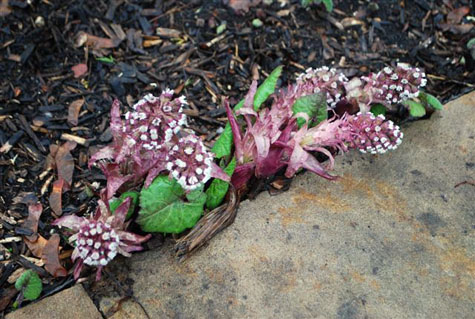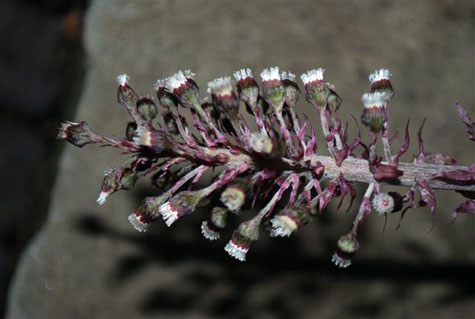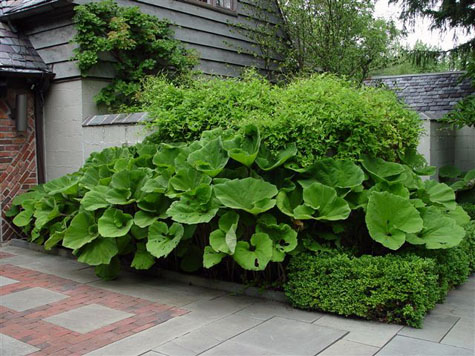 The temperatures still hover at or below the freezing mark here-typical for the Midwest. But there are signs of life. The butterburr flowers are stirring. They are preceded by huge cracks in the earth. Ungainly and ill-proportioned, they look dead as they emerge from the ground, and grow downwards back to the earth-astonishing. However unappetizing, these flowers are quickly replaced by giant, faintly prehistoric, leafy plants of equally astonishing scale. They form large colonies overnight-the kind that would spread into your house via the bedroom window-if you are not the vigilant sort.
The temperatures still hover at or below the freezing mark here-typical for the Midwest. But there are signs of life. The butterburr flowers are stirring. They are preceded by huge cracks in the earth. Ungainly and ill-proportioned, they look dead as they emerge from the ground, and grow downwards back to the earth-astonishing. However unappetizing, these flowers are quickly replaced by giant, faintly prehistoric, leafy plants of equally astonishing scale. They form large colonies overnight-the kind that would spread into your house via the bedroom window-if you are not the vigilant sort.
Their immense leaves are stunning. There is no texture like this, unless you live in the tropics.

How dramatically they fall to the ground in a heap when dry will make you laugh out loud. They compliment bitty -textured plants beautifully. But like many things in this world, they are willing to a fault. Give them an inch, and they will take Ohio. They spread uncontrollably, into the most unlikely places. The cracks in the driveway, the center of ancient and bristly yews-some surprise you by breaking forth many yards from their home. Shade will slow them down, should you have some. The butterburr battle is a loosing battle that I do not tire of. Once I spent days removing every scrap and shred of them from a large bed. In three weeks they were back with no sign that I had ever touched them. So I embrace them, and chase them. Our relationship is my idea of garden drama.
The design lesson here: the things you cannot change- the driveway you were dealt, the weather, the boundaries of your land, the butterburrs-make them work for you.
Give thought to where you are, who you are, and what you want. Most of all, sort out what you think is beautiful. Be prepared to revise these answers regularly. Then design. There could be butterburrs in your future.

 I did the project pictured many years ago in central Indiana. My client built this house in the middle of 80 acres of farmland. He and his wife tithed the use of this land, to grow corn, to their church. The landscape became a farm, and the farm was a landscape. All of the woody material was planted in rows, as if they were crops. I designed a pattern of the planting of the corn perpendicular to the woody planting of the landscape, so as to connect this very large house to a large piece of ground. This many years before I ever learned about crop circles.
I did the project pictured many years ago in central Indiana. My client built this house in the middle of 80 acres of farmland. He and his wife tithed the use of this land, to grow corn, to their church. The landscape became a farm, and the farm was a landscape. All of the woody material was planted in rows, as if they were crops. I designed a pattern of the planting of the corn perpendicular to the woody planting of the landscape, so as to connect this very large house to a large piece of ground. This many years before I ever learned about crop circles.  I was especially happy with this landscape, as I was able to persuade my client to commit to a big idea, and use smaller material, so as to keep within their budget. Big houses need big ideas as much as small houses do. I have never been back to see the project, but I hope that it is all still there, sturdy and strong.
I was especially happy with this landscape, as I was able to persuade my client to commit to a big idea, and use smaller material, so as to keep within their budget. Big houses need big ideas as much as small houses do. I have never been back to see the project, but I hope that it is all still there, sturdy and strong.
 OK, I have spent days detailing my childhood exposure and love of dirt-how does this pertain to you? Sculpting ground-this is a fancy definition for “grading”. Grading dirt, simply stated, it is the process of moving dirt around, so water drains, there are flat places to be, and the sculpture of the ground which will become your landscape, looks interesting, and beautiful. We can lower the dirt here; we can raise the dirt here. We can feather that area into this one. How the house sits on the land is a big issue for new homes-thus many cities require grading plans. The project pictured tried to address a specific landscape issue. A giant bumpy lawn on a considerable slope was not hospitable to either my client, or her guests. The space needed some flat ground, and a sense of some intimacy. The lawn was greatly over scaled for people. Nor was the shape of the lawn beautiful. With an earthmover, and rakes, the ground became sculptural and beautiful-but also useable. I call this a grass amphitheater.
OK, I have spent days detailing my childhood exposure and love of dirt-how does this pertain to you? Sculpting ground-this is a fancy definition for “grading”. Grading dirt, simply stated, it is the process of moving dirt around, so water drains, there are flat places to be, and the sculpture of the ground which will become your landscape, looks interesting, and beautiful. We can lower the dirt here; we can raise the dirt here. We can feather that area into this one. How the house sits on the land is a big issue for new homes-thus many cities require grading plans. The project pictured tried to address a specific landscape issue. A giant bumpy lawn on a considerable slope was not hospitable to either my client, or her guests. The space needed some flat ground, and a sense of some intimacy. The lawn was greatly over scaled for people. Nor was the shape of the lawn beautiful. With an earthmover, and rakes, the ground became sculptural and beautiful-but also useable. I call this a grass amphitheater.
 As I have said before, I have loved moving dirt my whole life. How this helps you is as follows. You have a life you are dealt, and a life you make. Look at what you were dealt, and imagine it better; imagine it beautiful, then move some dirt around.
As I have said before, I have loved moving dirt my whole life. How this helps you is as follows. You have a life you are dealt, and a life you make. Look at what you were dealt, and imagine it better; imagine it beautiful, then move some dirt around.

 I have made a career of designing landscapes yes, but I more importantly have forged relationships with people and the places they live. This one may want green rooms that provide refuge, and that one may need space for children playing soccer, and another wants to evoke a memory of a favorite place, and another who wants nothing but roses and more roses-and yet another for whom trees planted in an ocean of rough grass is sublimely beautiful. If the project is successful, each of us in turn learns something about what we really want. If I have my way, there will be discussion about the responsibility of stewardship, as opposed to the rights of ownership. After all, the dirt was there before each of us put our hand to it, and it is our responsibility that the hand we put to it now will leave it beautiful and healthy after us.
I have made a career of designing landscapes yes, but I more importantly have forged relationships with people and the places they live. This one may want green rooms that provide refuge, and that one may need space for children playing soccer, and another wants to evoke a memory of a favorite place, and another who wants nothing but roses and more roses-and yet another for whom trees planted in an ocean of rough grass is sublimely beautiful. If the project is successful, each of us in turn learns something about what we really want. If I have my way, there will be discussion about the responsibility of stewardship, as opposed to the rights of ownership. After all, the dirt was there before each of us put our hand to it, and it is our responsibility that the hand we put to it now will leave it beautiful and healthy after us.